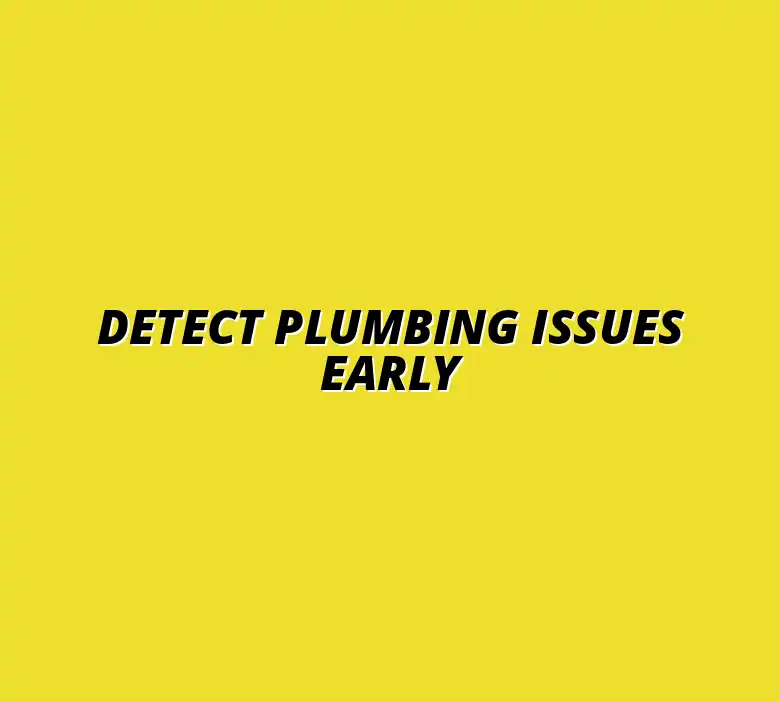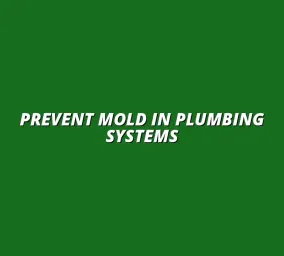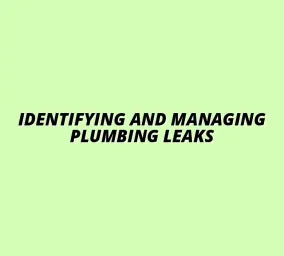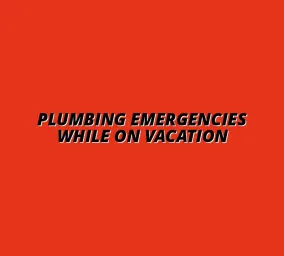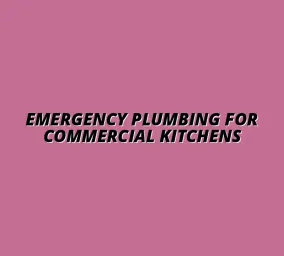Detect Plumbing Issues Early
Understanding the Importance of Early Plumbing Issue Detection
When it comes to plumbing, early detection is crucial! Ignoring small issues can lead to significant problems later on. By addressing plumbing concerns promptly, homeowners can avoid larger repairs and maintain a healthy living environment. For helpful plumbing maintenance tips for homeowners, check out this guide on plumbing maintenance.
Many people don’t realize that plumbing issues can escalate quickly. For instance, a tiny leak can eventually lead to extensive water damage, mold growth, or even structural problems in your home. So, being proactive can save you not just money but also a lot of stress!
Why Addressing Plumbing Issues Early Matters
Taking action on plumbing issues as soon as they arise is essential for several reasons. First, it helps keep your home safe from damage caused by water leaks. Water can cause rot, mold, and even compromise the integrity of your home. Learn more about preventing corrosion in water heaters, a common plumbing issue, by visiting this helpful resource.
Moreover, early detection can significantly reduce repair costs. It's often cheaper to fix a small issue now rather than waiting until it becomes a major problem. Let's explore some reasons why early detection is key:
- Minimized water damage
- Lower repair costs over time
- Improved home safety
- Increased property value
The Cost Implications of Ignoring Early Signs
Ignoring the early signs of plumbing problems can lead to hefty costs in the long run. Homeowners may find themselves facing not only repair bills but also expenses related to property damage, like mold remediation or structural repairs. For instance, a frozen pipe can cause significant damage. Here's how to prevent frozen pipes this winter.
For instance, a small leak that goes unattended can quickly turn into a flood, impacting floors, walls, and personal belongings. As you can see, the financial fallout of neglecting plumbing issues can be severe, making it essential to stay vigilant!
- Potential repair costs can skyrocket
- Insurance may not cover certain damages
- Loss of property value
Recognizing Common Signs of Plumbing Issues
Identifying plumbing issues early is about awareness. Understanding what to look for can help catch problems before they escalate. Let’s dive into some common signs that may indicate plumbing trouble!
By recognizing these signs, homeowners can take quick action, preventing extensive damage and costly repairs. For essential plumbing tips for homeowners, see this guide. Stay tuned as we explore these warning signals in detail!
Identifying Water Damage as an Early Warning
One of the first signs of plumbing issues is water damage. This can manifest in various ways, and it’s crucial to keep an eye out for these early warning signals. Water stains on walls or ceilings can indicate leaks that need immediate attention.
Another sign to watch for is any unusual increase in your water bill. If you notice a significant jump without an increase in usage, it could point to a hidden leak somewhere in your plumbing system. Here are some common indications:
- Wet spots on walls or ceilings
- Peeling paint or wallpaper
- Visible mold or mildew growth
Spotting Stains and Discoloration on Walls and Ceilings
Stains and discoloration on your walls and ceilings are clear signs of water damage. These stains might appear brown or yellow, signaling that moisture is present. If you see these signs, it’s time to investigate further!
Often, these stains indicate leaks from pipes hidden behind walls or ceilings. Addressing these issues early can prevent severe water damage and costly repairs down the line. Here are steps to take if you notice stains:
- Inspect the area closely for leaks
- Check for signs of moisture in nearby fixtures
- Contact a plumber if the source is unclear
Assessing the Impact of Musty Odors on Indoor Air Quality
Musty odors in your home can often signal hidden water problems. These odors typically arise from damp conditions or mold growth, which can thrive in moist environments. If you detect such smells, it’s essential to act swiftly!
Not only do musty odors indicate potential plumbing issues, but they can also affect your indoor air quality. This can lead to health problems for you and your family. If you're experiencing a clogged drain emergency, find immediate solutions here. If you experience musty smells, consider these tips:
- Investigate possible sources of moisture
- Check hidden areas like basements or crawl spaces
- Consider professional help for mold remediation if necessary
Unusual Sounds as Indicators of Plumbing Problems
Another way to detect plumbing issues is through unusual sounds coming from your pipes. If you're hearing gurgling or dripping noises, it’s time to investigate what's going on in your plumbing system!
These sounds can be more than just annoying; they often signal underlying problems that could lead to significant issues if left unchecked. Here are some common sounds and what they might mean:
- Gurgling noises can indicate blockages
- Dripping sounds may point to leaks
- Banging pipes could signal air in the system
Understanding the Significance of Gurgling Noises
Gurgling sounds often indicate that there’s an obstruction somewhere in your plumbing. This could be in your drain pipes or even in the toilet. If you hear these noises regularly, it might be time to check your plumbing!
Ignoring these sounds can lead to clogs that require professional attention. Identifying the source early can help you avoid a messy situation. Here’s what to do if you hear gurgling:
- Try using a plunger to clear minor clogs
- Inspect drain traps for buildup
- Consult a professional for severe clogs
Detecting Dripping Sounds and Their Potential Causes
Dripping sounds can be just as troublesome as gurgling noises. These sounds usually mean that a pipe is leaking or that there’s an issue with a faucet. Leaks can lead to water damage over time, so it’s important to address them quickly!
When you hear dripping, consider checking:
- Faucets for leaks
- Pipes under sinks
- Appliances like dishwashers or washing machines
Monitoring Water Pressure for Signs of Trouble
Water pressure is another important indicator of plumbing health. If you notice a sudden drop in water pressure, it could signal a problem in your plumbing system. Monitoring this can help you catch issues early!
Similarly, high water pressure can also lead to plumbing failures. For essential bathroom plumbing maintenance tips, check out this resource. It's important to maintain a balance! Here are ways to monitor water pressure:
- Use a pressure gauge to check the levels
- Observe the flow rate from faucets
- Note any changes in water pressure over time
How Low Water Pressure Can Indicate Underlying Issues
Low water pressure can be frustrating, especially when trying to shower or wash dishes. This issue can arise from several factors, including clogs, leaks, or even municipal supply problems. Identifying the cause is crucial for restoring normal water pressure!
If the pressure is suddenly low, check your fixtures and pipes for potential blockages. Regularly monitoring your water pressure can help prevent larger plumbing issues down the road.
The Role of High Water Pressure in Plumbing Failure
Conversely, high water pressure can be just as problematic. When your water pressure is too high, it can strain your pipes, leading to bursts or leaks. Installing a pressure regulator can help manage these levels.
Be sure to keep an eye on your plumbing system, as maintaining proper water pressure is essential for its longevity! If you need a plumber in Edgbaston, Birmingham, you can find one here.
Effective DIY Strategies to Identify Plumbing Problems
Detecting plumbing problems early is essential for saving time and money. With some basic knowledge and tools, you can conduct your own assessments to catch issues before they worsen. Not only can this give you peace of mind, but it can also empower you to take action quickly when problems arise!
In this section, we’ll explore some effective DIY strategies you can use to identify plumbing problems. From checking for leaks to evaluating drainage systems, you'll find practical tips that anyone can follow!
How to Check for Leaks Without Professional Help
One of the first steps in identifying plumbing issues is checking for leaks. Leaks can lead to significant water waste and costly repairs if left unchecked. Thankfully, you can use simple methods to figure out if your home has any hidden leaks!
- Utilizing the Water Meter Test for Leak Detection: To perform this test, turn off all water sources in your home and note the reading on your water meter. Wait for a few hours without using any water, and check the meter again. If the reading has changed, you likely have a leak.
- Visual Inspections: What to Look For Around Your Home: Walk through your house and inspect areas like under sinks, around toilets, and near water heaters. Look for signs of moisture, puddles, or corrosion, which could indicate a leak.
Utilizing the Water Meter Test for Leak Detection
This method is simple and effective! By monitoring your water meter, you can quickly identify if any unexpected water usage is occurring. Remember to make sure all faucets and appliances are off during your test.
In addition to the water meter test, it’s also a good idea to check your water bill regularly. If you notice an unexplained rise in your bill, it may be time to conduct a more thorough inspection.
Visual Inspections: What to Look For Around Your Home
When conducting visual inspections, pay special attention to areas that are prone to leaks. Common places include:
- Sinks and faucets
- Toilets and their connections
- Water heaters and surrounding areas
- Basements and crawl spaces
By keeping an eye on these locations, you can catch leaks before they turn into bigger problems!
Testing Drainage Systems for Blockages
Another vital aspect of plumbing maintenance is testing your drainage systems. Slow drains can be an early sign of clogs, which can lead to more severe issues if not addressed. Here are some straightforward methods to assess how well your drains are functioning!
- Simple Methods for Assessing Drain Flow Efficiency: Fill your sink or tub with water, then release it and observe how quickly it drains. If the water takes a long time to disappear, you may need to investigate further.
- Recognizing Signs of Clogs Before They Escalate: Look out for slow draining, water backing up, or unusual smells coming from your drains. These could indicate that a blockage is forming.
Simple Methods for Assessing Drain Flow Efficiency
By testing the flow of water in your drains regularly, you can catch problems early! If you notice slow draining, try using a plunger or a drain snake to clear minor clogs before they become major issues.
Keeping your drains clean is also essential. Consider flushing your drains monthly with hot water or a mixture of baking soda and vinegar to help prevent clogs!
Recognizing Signs of Clogs Before They Escalate
Being proactive about your drainage systems can save you a lot of hassle! Don't ignore unusual signs. Instead, take action by investigating your drains and doing routine maintenance.
By using these easy DIY strategies, you'll be well-equipped to identify plumbing problems early on. Remember, taking care of small issues today can prevent hefty repairs tomorrow!
Frequently Asked Questions About Early Detection of Plumbing Issues
As you learn more about plumbing issues, you might have questions about how to address them effectively. Here, we’ll cover some frequently asked questions that many homeowners have regarding early detection and maintenance.
What Are the Most Common Plumbing Problems Homeowners Face?
Homeowners often encounter several common plumbing problems. Some of these include:
- Leaky faucets
- Clogged drains
- Running toilets
- Low water pressure
How Often Should Homeowners Conduct Plumbing Inspections?
It's a good idea to conduct a plumbing inspection at least once a year. However, if you notice signs of trouble, such as unusual sounds or visual leaks, it's best to inspect sooner. Regular inspections can help catch problems before they escalate!
When Is It Essential to Call a Professional Plumber?
Sometimes, plumbing issues can be complex and require the expertise of a professional plumber. Here are some scenarios where it’s best to call in an expert:
- Severe leaks that you can't locate
- Multiple clogged drains throughout your home
- Major plumbing overhauls or installations
Knowing when to seek professional help can save you time, stress, and money. Don’t hesitate to reach out if you’re uncertain!
Steps to Take When Plumbing Issues Are Detected
Once you've identified a plumbing issue, it's important to know how to address it. In this section, we'll cover what steps to take when you detect a problem, whether it’s a simple fix or something that requires professional attention.
Determining When DIY Solutions Are Sufficient
Many minor plumbing issues can be tackled with DIY solutions! If you feel confident and have the right tools, consider addressing:
- Changing out faucet washers
- Clearing minor clogs with a plunger
- Replacing toilet flappers
However, if the issue persists or worsens, it may be time to seek professional help!
Knowing When to Seek Professional Help Effectively
It's crucial to recognize when a plumbing issue is beyond your skill level. If you find yourself facing a situation like:
- Unexplained water pooling
- Persistent clogs despite your efforts
- Water damage or significant leaks
Don't hesitate to call a professional plumber. It’s always better to be safe than sorry when it comes to plumbing!
Recap of Key Strategies for Early Detection of Plumbing Issues
In summary, identifying plumbing problems early can save you a significant amount of time and money. Regular inspections, proactive measures, and DIY strategies empower homeowners to maintain their plumbing systems effectively.
Summarizing Effective Detection Techniques
Utilizing methods like water meter tests, visual inspections, and checking drainage systems can help you stay ahead of potential plumbing issues. Remember to be vigilant and proactive!
Encouraging Regular Maintenance for Long-Term Plumbing Health
Regular maintenance is key to plumbing health! By scheduling routine inspections and addressing minor issues promptly, you can ensure that your plumbing system remains in top shape for years to come.

